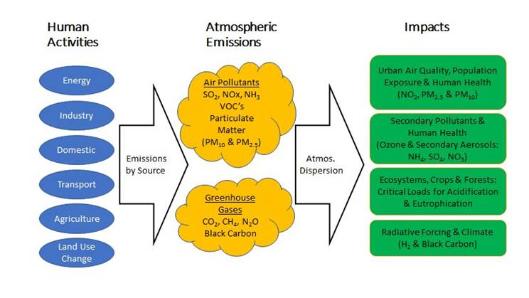Integrated Assessment Unit
Strategies to control emissions to the atmosphere & their environmental impacts

Research within the Integrated Assessment Unit (IAU) is focused on the development of national and international policy on control of emissions to the atmosphere and their environmental impacts. Following Brexit, we have increasingly focused on scenario analysis and future air pollution in the UK, and development of targets for improvement. Despite improvements in air quality in Europe there are still serious problems for human health and protection of the natural environment. Many of the human activities contributing to air pollution problems at local to transboundary scales also generate greenhouse gas emissions. Reciprocally measures to reduce greenhouse gases in Net Zero scenarios also affect emissions of air pollutants. Thus, air quality issues and climate change are closely linked, such that strategies to address the former can affect the latter, and vice versa. There are both environmental and economic benefits from considering both together.
Recent moves towards decarbonisation and Net Zero strategies means that air pollutant emissions are expected to reduce as fossil fuels are replaced with low-carbon alternatives, such as hydrogen. and/or electrification in parallel with increasing energy generation from renewables. Our work explores future air quality in the UK superimposing air pollution abatement measures and behavioural change on alternative energy scenarios, including direct linking of our UK integrated assessment model, UKIAM, to energy projection modelling; and exploration of the air pollution impacts of new technologies such as those producing and using hydrogen.
The Integrated Assessment Unit has many years of experience in research on control of transboundary air pollution, closely linked to the development of international protocols under the Convention on Long-Range Transport of Air Pollution of the UN Economic Commission for Europe. It has also undertaken more detailed studies at the UK scale related to compliance with EC legislation and the Clean Air for Europe programme, followed post Brexit by modelling of future UK scenarios to support development of new targets for reducing fine particulate pollution in the Environment Act. As indicated above this work includes the synergies between control of air quality pollutants and greenhouse gases. Increasingly the reduction of atmospheric emissions in Europe and the UK needs to be set in the context of changing emissions elsewhere in the world. The IAU interacts strongly with other DEFRA contractors and is the base for the UK National Focal Centre for Integrated Assessment Modelling. Find out more about Integrated Assessment Modelling.
As the base for the UK National Focal Centre for Integrated Assessment Modelling, the IAU collaborates with related research both nationally and internationally.
Applications/Drivers
- Transport
- Energy, Industry & Synergies with Climate Change
- Agricultural & Land Use Change
- Domestic
- Impacts (health & environmental)
Selected Publications
- ApSimon, H.; Oxley, T.; Woodward, H.; Mehlig, D.; Holland, M.; Reeves, S., 2023, Integrated Assessment Modelling of Future Air Quality in the UK to 2050 and Synergies with Net-Zero Strategies. Atmosphere 2023, 14, 525. https://doi.org/10.3390/atmos14030525
- Oxley, T., Dore, A., ApSimon, H., Hall, J. & Kryza, M., 2013, Modelling future impacts of air pollution using the multi-scale UK Integrated Assessment Model (UKIAM), Environment International, 61, pp 17-35, https://doi.org/10.1016/j.envint.2013.09.009
- ApSimon H, Amann M, Astrom S, Oxley T, 2009, Synergies in addressing air quality and climate change, Climate Policy, Vol:9, Pages:669-680, ISSN:1469-3062, http://doi.org/10.3763/cpol.2009.0678
- Smith, A., Holland, M., Korkeala, O., Warmington, J., Forster, D., ApSimon, H., Oxley, T., Dickens, R. & S. Smith, 2015, Health and environmental co-benefits and conflicts of actions to meet UK carbon targets, Climate Policy, https://doi.org/10.1080/14693062.2014.980212


